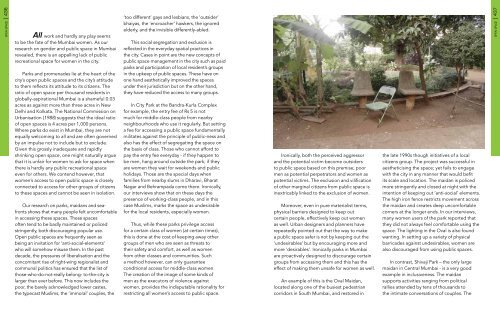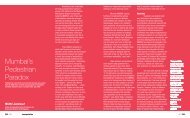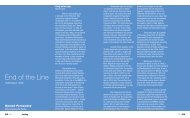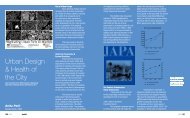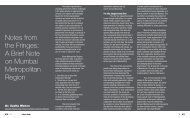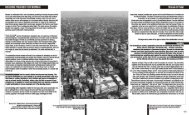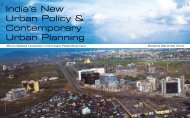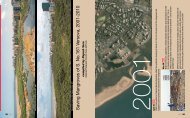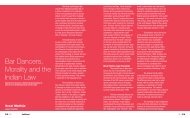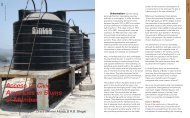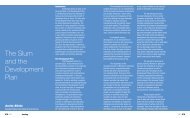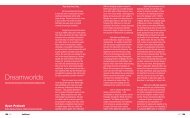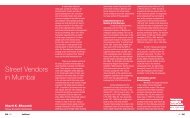Entry Restricted, Open Public Spaces in Mumbai.pdf - Urban Design ...
Entry Restricted, Open Public Spaces in Mumbai.pdf - Urban Design ...
Entry Restricted, Open Public Spaces in Mumbai.pdf - Urban Design ...
- No tags were found...
You also want an ePaper? Increase the reach of your titles
YUMPU automatically turns print PDFs into web optimized ePapers that Google loves.
OPEN SPACE | 436All work and hardly any play seemsto be the fate of the <strong>Mumbai</strong> women. As ourresearch on gender and public space <strong>in</strong> <strong>Mumbai</strong>revealed, there is an appall<strong>in</strong>g lack of publicrecreational space for women <strong>in</strong> the city.Parks and promenades lie at the heart of thecity’s open public spaces and the city’s attitudeto them reflects its attitude to its citizens. Theratio of open space per thousand residents <strong>in</strong>globally-aspirational <strong>Mumbai</strong> is a shameful 0.03acres as aga<strong>in</strong>st more than three acres <strong>in</strong> NewDelhi and Kolkata. The National Commission on<strong>Urban</strong>isation (1988) suggests that the ideal ratioof open spaces is 4 acres per 1,000 persons.Where parks do exist <strong>in</strong> <strong>Mumbai</strong>, they are notequally welcom<strong>in</strong>g to all and are often governedby an impulse not to <strong>in</strong>clude but to exclude.Given this grossly <strong>in</strong>adequate and rapidlyshr<strong>in</strong>k<strong>in</strong>g open space, one might naturally arguethat it is unfair for women to ask for space whenthere is hardly any public recreational spaceeven for others. We contend however, thatwomen’s access to open public space is closelyconnected to access for other groups of citizensto these spaces and cannot be seen <strong>in</strong> isolation.Our research on parks, maidans and seafrontsshows that many people felt uncomfortable<strong>in</strong> access<strong>in</strong>g these spaces. These spacesoften tend to be badly ma<strong>in</strong>ta<strong>in</strong>ed or policedstr<strong>in</strong>gently, both discourag<strong>in</strong>g popular use.<strong>Open</strong> public spaces are frequently seen asbe<strong>in</strong>g an <strong>in</strong>vitation for ‘anti-social-elements’who will somehow misuse them. In the pastdecade, the pressures of liberalisation and theconcomitant rise of right-w<strong>in</strong>g regionalist andcommunal politics has ensured that the list ofthose-who-do-not-really belong- to-the-city islarger than ever before. This now <strong>in</strong>cludes thepoor, the barely acknowledged lower castes,the typecast Muslims, the ‘immoral’ couples, the‘too different’ gays and lesbians, the ‘outsider’bhaiyas, the ‘encroacher’ hawkers, the ignoredelderly, and the <strong>in</strong>visible differently-abled.This social segregation and exclusion isreflected <strong>in</strong> the everyday spatial practices <strong>in</strong>the city. Cases <strong>in</strong> po<strong>in</strong>t are the new concepts ofpublic space management <strong>in</strong> the city such as paidparks and participation of local resident’s groups<strong>in</strong> the upkeep of public spaces. These have onone hand aesthetically improved the spacesunder their jurisdiction but on the other hand,they have reduced the access to many groups.In City Park at the Bandra-Kurla Complexfor example, the entry fee of Rs 5 is notmuch for middle-class people from nearbyneighbourhoods who use it regularly. But sett<strong>in</strong>ga fee for access<strong>in</strong>g a public space fundamentallymilitates aga<strong>in</strong>st the pr<strong>in</strong>ciple of public-ness andalso has the effect of segregat<strong>in</strong>g the space onthe basis of class. Those who cannot afford topay the entry fee everyday - if they happen tobe men, hang around outside the park; if theyare women they wait for weekends and publicholidays. Those are the special days whenfamilies from nearby slums <strong>in</strong> Dharavi, BharatNagar and Behrampada come there. Ironically,our <strong>in</strong>terviews show that on these days thepresence of work<strong>in</strong>g-class people, and <strong>in</strong> thiscase Muslims, marks the space as undesirablefor the local residents, especially women.Thus, while these parks privilege accessfor a certa<strong>in</strong> class of women (at certa<strong>in</strong> times),this is done at the cost of keep<strong>in</strong>g away othergroups of men who are seen as threats totheir safety and comfort, as well as womenfrom other classes and communities. Sucha method however, can only guaranteeconditional access for middle-class women.The creation of the image of some k<strong>in</strong>ds ofmen as the executors of violence aga<strong>in</strong>stwomen, provides the <strong>in</strong>disputable rationality forrestrict<strong>in</strong>g all women’s access to public space.Ironically, both the perceived aggressorand the potential victim become outsidersto public space based on this premise; poormen as potential perpetrators and women aspotential victims. The exclusion and vilificationof other marg<strong>in</strong>al citizens from public space is<strong>in</strong>extricably l<strong>in</strong>ked to the exclusion of women.Moreover, even <strong>in</strong> pure materialist terms,physical barriers designed to keep outcerta<strong>in</strong> people, effectively keep out womenas well. <strong>Urban</strong> designers and planners haverepeatedly po<strong>in</strong>ted out that the way to makea public space safer is not by keep<strong>in</strong>g out the‘undesirables’ but by encourag<strong>in</strong>g more andmore ‘desirables’. Ironically parks <strong>in</strong> <strong>Mumbai</strong>are proactively designed to discourage certa<strong>in</strong>groups from access<strong>in</strong>g them and this has theeffect of mak<strong>in</strong>g them unsafe for women as well.An example of this is the Oval Maidan,located along one of the busiest pedestriancorridors <strong>in</strong> South <strong>Mumbai</strong>, and restored <strong>in</strong>the late 1990s though <strong>in</strong>itiatives of a localcitizens group. The project was successful <strong>in</strong>aestheticis<strong>in</strong>g the space; yet fails to engagewith the city <strong>in</strong> any manner that would befitits scale and location. The maidan is policedmore str<strong>in</strong>gently and closed at night with the<strong>in</strong>tention of keep<strong>in</strong>g out ‘anti-social’ elements.The high iron fence restricts movement acrossthe maidan and creates deep uncomfortablecorners at the longer ends. In our <strong>in</strong>terviews,many women users of the park reported thatthey did not always feel comfortable us<strong>in</strong>g thespace. The light<strong>in</strong>g <strong>in</strong> the Oval is also foundwant<strong>in</strong>g. In sett<strong>in</strong>g up a variety of physicalbarricades aga<strong>in</strong>st undesirables, women arealso discouraged from us<strong>in</strong>g public spaces.In contrast, Shivaji Park – the only largemaidan <strong>in</strong> Central <strong>Mumbai</strong> - is a very goodexample <strong>in</strong> <strong>in</strong>clusiveness. The maidansupports activities rang<strong>in</strong>g from politicalrallies attended by tens of thousands tothe <strong>in</strong>timate conversations of couples. TheOPEN SPACE | 437


